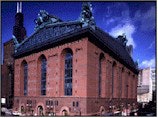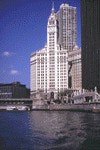
After walking the floor of McCormick Place all day, the last thing that you might want to do is to, well, go for a walk.
But downtown Chicago offers a wealth of architectural gems and oddities that are mere steps away from your hotel. AuntMinnie.com has crafted a few walkabout routes that will give you the opportunity to visit these sites, enjoy Chicago’s crisp fall weather, and even learn a little more about your host city. Just remember: Lake Michigan is always to the east!
|
Best Western Grant Park Hotel |
Congress Plaza Hotel |
|
Blackstone Hotel |
Essex Hotel |
|
Chicago Hilton and Towers |
Hyatt on Printers Row |
Most appropriate for those staying at:
|
Clarion Executive Plaza Hotel |
Hyatt Regency Hotel |
|
Fairmont Hotel |
Sheraton Chicago Hotel & Towers |
|
Hotel Intercontinental |
Swissotel Chicago |
Most appropriate for those staying at:
| Allerton Crowne Plaza | Doubletree Guest Suite Hotel | Hotel Intercontinental |
| Best Western Inn of Chicago | Drake Hotel | Summerfield Suites |
| Chicago Downtown Marriott | Embassy Suites Downtown Chicago | Sutton Place Hotel |
| Courtyard by Marriott/Downtown | Four Seasons Hotel | Talbott Hotel |
| Tremont Hotel |
Most appropriate for those staying at:
|
Allegro Hotel Chicago |
Midland Hotel |
|
Clarion Executive Plaza Hotel |
Palmer House Hilton |
|
Crowne Plaza Silversmith |
Renaissance Hotel Chicago |
 |
Start at the Congress Plaza Hotel (520 S. Michigan Ave.) and walk north to Congress Parkway. Turn left and walk about three blocks west to the Harold Washington Library (at left, 400 S. State St.). The nation’s largest public library, this 10-story building was completed around 1990. The appropriateness of its architectural design -- the gargoyles signifying wisdom and knowledge and its general oversized appearance -- has proved controversial. |
Head north on State Street. If you really like architecture from the 1890s, go north just one block and then turn left on Jackson Boulevard. Proceed about one block, and you’ll reach the Monadnock Building, which was built in 1893. This 16-story building was the largest commercial office building in the world when it was completed. Walls at the ground level are six feet thick!
Back to State Street. You’re now heading north on State Street, which was Chicago’s grandest commercial street back in the 1940s. The street has lost much of its luster since then, although at Jackson and State streets is DePaul University’s brand-new downtown campus.
Head north to Adams Street, and then turn right, going east, toward Lake Michigan. Take Adams to Michigan Avenue, and cross the street. You’re now standing in front of The Art Institute of Chicago. The oldest part of the institute dates back to 1893. The two giant stone lions that normally flank the main entrance have been removed during an 18-month renovation project.
Cross the street again, and turn left, heading south on Michigan Avenue back toward your hotel. On your way, you’ll pass Orchestra Hall, 220 S. Michigan Ave., the home of the Chicago Symphony Orchestra. Keep heading south on Michigan Avenue back to your hotel.
Start at the northeast corner of Michigan and Wacker Drives. You’re standing on top of a double-decker road! Just below you is a full-use street that’s also called Wacker Drive, used primarily by drivers to bypass downtown. It was featured in the 1980 film The Blues Brothers.
Walk down the staircase, and along the north side of Lower Wacker Drive. The Chicago River is alongside you, just to the north. You can proceed toward the river, and spend some time in the parks.
Continue east on Wacker Drive and turn left at your first opportunity, which is Columbus Drive. Take Columbus across the river, and walk one block north. Make sure you’re on the east side of Columbus Drive, and you’ll notice that on the southeast corner of Columbus Drive and North Water Street, there’s an amusing-looking plaza, with several large metal sculptures. This is Ogden Park, featuring a working horizontal clock, which provides accurate time.
Go back across Columbus Drive and take a look at the NBC Tower. Built in 1989, this building is the home of several well-known talk shows, including The Jerry Springer Show. Keep walking east on North Water Street, which ends at a building owned by the University of Chicago. To the right of the university’s building, you’ll see an attractive plaza with trees, fountains, and trellises. This is called Pioneer Court. You’re now on the south side of the Tribune Tower, a neo-Gothic building that is the home of the Chicago Tribune newspaper. Once the tallest building in Chicago, the 36-story tower was designed by architects Raymond Hood and John Mead Howells in 1922 after they won a national contest soliciting designs for the building.
Proceed to the front of the Tribune Tower, which is on Michigan Avenue. Note the "showcase" radio studio in the front of the building, used by Tribune-owned WGN radio.
 |
Next, cross Michigan Avenue and gaze up at the Wrigley Building (410 N. Michigan Ave.). Once the headquarters for the Wrigley chewing gum company, this white, terracotta building has a tower that was modeled on the Giralda of the Cathedral in Seville, Spain. |
Continue south on Michigan Avenue, and cross the Chicago River. Look to the west and note the Chicago Sun-Times’ newspaper building, which is just west of the Wrigley Building, and the two-structure Marina Towers complex. Built in 1962, these 60-story towers have parking lots on their first 20 stories. At the time they were built, they were the tallest residential buildings -- and the tallest concrete structures -- in the world. In The Hunter, a 1980 movie starring Steve McQueen, a car drove off one of the parking decks into the Chicago River.
Proceed south across the river to your starting point.
Alternate Eastside Route
Start on the east side of Michigan Avenue at Wacker Drive and head south. Proceed about three blocks, noticing two buildings: the 71-year-old Carbide & Carbon Building (230 N. Michigan Ave.), which has a polished granite base and a green terracotta tower, and the Stone Container Building, which has a much-photographed, diamond-shaped design.
Continuing with the walk, turn left on Randolph Street. As you head east on Randolph, note on your right is a park that’s under construction. The park is the far north end of Grant Park. When completed in 2001, the $230 million Millennium Park will have a band shell for live concerts.
On your right, the buildings include the Prudential building, which has an exterior form of the Rock of Gibraltar, the company’s logo. This building was Chicago’s tallest when it was built in 1955. Continuing east, you’ll pass Two Prudential Plaza, which is an Art Deco-inspired modern skyscraper. The Amoco Building has 80 stories and is the second tallest building in Chicago. Originally covered with thin slabs of marble, the Amoco building’s exterior was completely replaced by granite in 1992 after climate changes caused the marble to deteriorate.
Feel free to enter the building’s plaza, which has a waterfall, a reflecting pool, and a sculpture that chimes when the wind blows.
Turn left on Columbus Drive, and proceed north. You’ll walk past Family Golf Centers, a 9-hole golf course. Turn left on Wacker Drive and head west back to Michigan Avenue.
Begin at the corner of Chicago and Michigan avenues. For those of you who have to walk north from your hotels to get to this location, you know that this is the premier shopping district in Chicago. However, the street, also known as the Magnificent Mile, offers some impressive architecture as well.
Standing at this corner, face the building at the northwest corner. Called the Park Tower, this 844-foot, 67-story building was completed in summer 2000. It has a hotel on its lower floors, luxury condominiums on its middle floors, and individual penthouses on each of the top eight floors.
 |
Looking to the northeast, you’ll see the original Water Tower, one of the few buildings that was not destroyed in the Great Fire that ravaged central Chicago in 1871. Walking north on the east side of the street, you’ll approach Water Tower Place, the tallest reinforced concrete building in the world and the first multistory urban shopping mall. Behind the seven-story mall is the rest of the building, which houses a hotel, 260 condominium units, and offices. Media mogul Oprah Winfrey lives here on the 56th floor. |
Continuing on Michigan Avenue, you’ll come to the black, X-braced John Hancock Center. Chicago’s third tallest building, the Hancock has a restaurant and bar with beautiful views on its 95th and 96th floors.
Across the street is one of Chicago’s few cathedral-like churches, Fourth Presbyterian Church of Chicago. Just to the north of the church is 900 N. Michigan Ave. Completed in the 1980s, the building is the home of Bloomingdale’s department store. Tennis star Billie Jean King lives on the 57th floor.
Continue north on Michigan Avenue until you reach Lake Shore Drive. Turn right on East Lake Shore Drive and walk past some of Chicago’s most expensive apartments, including Drake Tower. These buildings, many of which date to the 1920s, are mostly co-operative housing for some of the wealthiest Chicagoans. Advice columnist Ann Landers lives along this stretch at 209 E. Lake Shore Drive.
Follow Lake Shore Drive as it curves to the south, until you reach the simple, twin apartment towers at 860 and 880 N. Michigan Ave. These glass-and-steel buildings, which are about 50 years old, are celebrated for their minimal elegance. Designed by architect Ludwig Mies van der Rohe, they have served as prototypes for glass and steel skyscrapers in cities globally. In 1996, the towers achieved landmark status so they cannot be modified without approval from Chicago’s landmark commission.
Continue south on Lake Shore Drive to Chicago Avenue and then turn right. As you return to Michigan Avenue, note several Northwestern University buildings on your left.
 |
Begin in front of the Midland Hotel (172 W. Adams St.). Head east for a half-block on Adams, and then turn right, going south on LaSalle Street. At the southeast corner of this intersection is the Rookery, a building that dates to 1888. Designed by architects Daniel Burnham and John Wellborn Root and named because the building resembles the rook in a chess game, the Rookery (at left) was the tallest building in the world when it was built. Take a look inside the lobby if it’s open. Architect Frank Lloyd Wright updated the space in 1907, redoing the mezzanine staircase in white marble and adorning it with gold leaf. |
Continuing south on LaSalle, you reach the Art Deco-style Chicago Board of Trade, home of the futures markets. Have a look inside the two-story lobby if possible. Note the statue of Ceres (the Roman goddess of fertility, livestock, and agriculture), which towers over the streets, known to locals as LaSalle Street Canyon.
Turn right on Jackson Street, and proceed west for three blocks. You are now standing in between the Sears Tower and 311 S. Wacker Dr.. At 1,454 feet tall, the Sears Tower is the tallest building in the United States and is the corporate headquarters for the department store chain of the same name. With its bright white crown and height of 970 feet, 311 S. Wacker Dr. is Chicago’s sixth-tallest building.
Turn right on Wacker Drive and walk north to Monroe Street. Then, turn right on Monroe and walk about three blocks back to LaSalle Street. Turn left on LaSalle and take a look up at 10 S. LaSalle St., which sits on the west side between Monroe and Madison Streets. From the third floor up, the bright blue glass-and-steel skyscraper houses Chase Bank.
Walk one block north to 120 N. LaSalle St. It is a relatively nondescript office tower, until you see the mural above its entryway called Flight of Daedalus & Icarus. Across the street is a short, long building where the government offices of Cook County are. You might recognize the interior if you saw The Fugitive, starring Harrison Ford in 1993.
Walk one more block north to 160 N. LaSalle St., a 76-year-old building known as the Old State of Illinois building. Suspended between the sixth and ninth floors is Free Form, a sculpture that has been in place since 1993.
Across the street, at 100 W. Randolph St., is the new State of Illinois building. Designed by architect Helmut Jahn in the 1980s, the colorful 16-story tower makes a definite splash in a neighborhood filled with older stone and granite buildings.
Continue east on Randolph Street and then turn south on Clark Street. Walk around to the front of the Richard J. Daley Center, also known as the Cook County Courthouse. The rust-colored Daley Center, named for the man who was Chicago’s mayor from 1955 to 1976, is considered an important community gathering place. In the middle of the plaza is a 50-foot-tall metal sculpture by Pablo Picasso.
Washington Street goes along the south edge of Daley Plaza. Take Washington west to LaSalle Street, turn left on LaSalle, and walk three blocks south to Adams Street. Turn right on Adams and walk a half-block back to the Midland Hotel.
By Bob Goldsborough
AuntMinnie.com contributing writer
November 15, 2000
Copyright © 2000 AuntMinnie.com



















